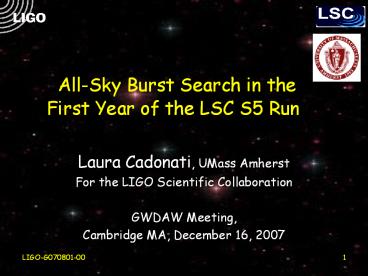All-Sky Burst Search in the First Year of the LSC S5 Run - PowerPoint PPT Presentation
1 / 19
Title:
All-Sky Burst Search in the First Year of the LSC S5 Run
Description:
Time coincidence. and. Frequency clustering. BlockNormal / AstroBurst ... Time & frequency coincidence, clustering. Q-pipeline. H null stream. H coherent sum ... – PowerPoint PPT presentation
Number of Views:18
Avg rating:3.0/5.0
Title: All-Sky Burst Search in the First Year of the LSC S5 Run
1
All-Sky Burst Search in the First Year of the
LSC S5 Run
- Laura Cadonati, UMass Amherst
- For the LIGO Scientific Collaboration
- GWDAW Meeting,
- Cambridge MA, December 16, 2007
2
All-sky Burst Search
- All-sky search for un-modeled bursts of
gravitational waves - Supernovae, black hole mergers, serendipitous
sources - approaching completion of the analysis for the
first year of S5 (Nov 14, 2005 to Nov 14, 2006) - 3 searches (different techniques)
- Exploring different network configurations
- Candidates must pass data quality and consistency
tests, designed to suppress false alarms with
minimal impact to sensitivity
3
Detector Combinations?
1st year available data after category 1 data
quality flags
H1H2 247.4 days 66.0 H1L1 183.3 days
48.9 H2L1 185.1 days 49.3 H1H2L1 168.9
days 45.0 G1 223.8 days 59.7
4
3 Analysis Techniques
- Actually..
- 3 complete analysis pipeline,
- sharing data quality/veto, simulation engine and
candidate follow-up
5
BlockNormal / AstroBurst
H1
BandPass, BN
Time coincidence and Frequency clustering
Astrophysical interpretation
Waveform consistency test
H2
BandPass, BN
L1
BandPass, BN
Change points
Event threshold
6
Q-pipeline
Optimal coherent combination
H1
Time frequency coincidence, clustering
Coherent followups
Multiresolution Q-transform
H2
Multiresolution Q-transform
L1
H coherent sum
H null stream
Simulated 1.4/1.4 M?inspiral at 5Mpc
consistent with noise
10 increase in SNR
7
Coherent WaveBurst
H1
Burst Candidates
H2
L1
coherent statistic L(t,f)
frequency
?
time
8
Strengths of Each Analysis
- BlockNormal/AstroBurst
- Statistical robustness. Avoids frequency regions
of non stationary noise. Single-interferometer
efficiency curves for astrophysical population
interpretation. - Q-pipeline
- optimal use of H1 and H2 to maximize SNR and
provide strong constistency test to distinguish
burst candidates from noise transients. - Coherent WaveBurst
- coherent combination of data from an any
detector network. - Status
- all three searches in advanced stage
(background with time slides, efficiency studies,
review). Current plan (may change) is to open
the box for all three simultaneously once they
are ready and we have a plan for how to combine
results.
9
Some Issues / Highlights
10
Data Quality and Veto
- Known data quality issues flagged by detector
characterization team used as veto - Organized in 4 categories
- DQ veto classification decided a priori based on
efficiency on removing single-interferometer
transients and dead time and on accidental
triple coincidences. - For details, please see poster by L. Blackburn
- Additional veto correlations between
single-interferometer transients on 300
auxiliary channels and the gravitational-wave
channel - Veto-yield on single-instrument glitches is 10
of outliers (10-21 sqrt(Hz) and above), with
0.5 dead time - However, veto efficiency for individual channels
is strongly time-dependent during the S5 run
time-dependent tuning? - Also considering different vetoes for each of the
3 analyses
11
Time Dependence
380 days since Nov.15, 2005
preliminary
1 year of coherent WaveBurst triggers (100
time-lags)
64 Hz-2048 Hz
12
Frequency Dependence
preliminary
preliminary
From Q-pipeline, Excess w/r/t gaussian Unclustered
triggers with SNRgt5
From coherent WaveBurst, after cut, on
cross-correlation statistics, no data quality
100 time lags, total live time 46 years
A random H1 day, no data quality
13
H1-H2
- Livetime in the first year
- H1H2L1 179 days
- H1H2 257 days (additional 78 days to be
searched) - We are working on issues to be solved when
comparing H1H2 and H1H2L1 - In particular, correlated noise transients in the
two Hanford detectors (mostly at low frequency) - ? need the full veto power of
- a null-stream analysis
preliminary
Strength of single-interferometer transients
found within 50ms in H1 and H2. First-year
sample used for veto studies.
14
Follow-up
- Developed a detection checklist to follow up
candidate events that pass the consistency tests
built in each of the three analysis pipelines. - For details, talk by R. Gouaty
- Among the new features, developing algorithms for
waveform reconstruction and sky maps with the
coherent event display (here is an example of
simulated signal on band-limited noise). - See Coherent Event Display poster by A. Mercer
L1
H1
Simulated signal, sine-gaussian 1304Hz Q9 Red
reconstructed response
15
Expected Reach in S5
- Estimated from the first 5 months of the run,
with the same analysis method used in the
previous run (S4)
16
Detection Efficiency / Range
Instantaneous energy flux
Detection Probability
Assume isotropic emission to get rough
estimates For a sine-Gaussian with Qgtgt1 and
frequency f0
17
Detection Efficiency / Range
Q 8.9 sine-Gaussians, 50 detection probability
preliminary
Virgo cluster
typical Galactic distance
For a 153 Hz, Q 8.9 sine-Gaussian, the S5 search
can see with 50 probability ? 2 108 M?
c2 at 10 kpc (typical Galactic distance) ?
0.05 M? c2 at 16 Mpc (Virgo cluster)
18
Order of Magnitude Range Estimate for Supernovae
and BH Mergers
Model dependent!
19
Conclusion
- All-sky S5 burst search in progress, using 3
independent pipelines. - Exploring combinations of L1, H1 and H2 when
available, GEO data used for follow-up. Details
of how to combine results are still to be
finalized. - Also under discussion how to combine results
from the 3 searches. - In the spirit of blind analysis, the current plan
(may change!) is to open the box once 3
analyses are ready.































